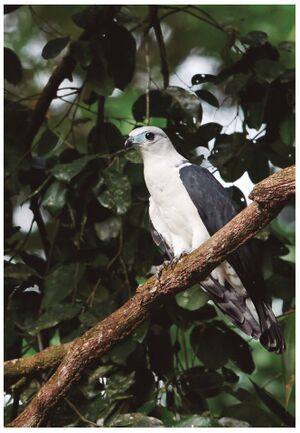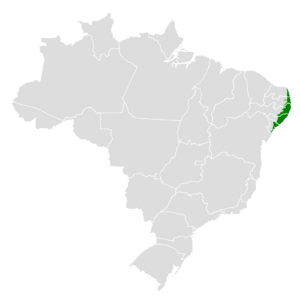White-collared kite facts for kids
Quick facts for kids White-collared kite |
|
|---|---|
 |
|
| Conservation status | |
| Scientific classification | |
| Genus: |
Leptodon
|
| Species: |
forbesi
|
 |
|
| White-collared kite range | |
The white-collared kite (scientific name: 'Leptodon forbesi') is a type of bird that lives in northeastern Brazil. It belongs to a group of birds called Accipitridae, which are birds of prey that hunt during the day. This amazing bird is currently an Endangered species, meaning it's at high risk of disappearing forever.
Contents
About the White-collared Kite
What is Taxonomy?
For a long time, people thought the white-collared kite was just a different-looking grey-headed kite (L. cayanensis). But in the early 2000s, scientists looked closely at its body and other clues. They found strong evidence that it is its own unique species. This bird is monotypic, which means it's the only species in its group.
The scientific name forbesi honors a British zoologist named William Alexander Forbes.
How to Identify This Bird
The white-collared kite is about 50 centimeters (20 inches) long. It weighs between 550 and 580 grams (about 1.2 pounds).
Most adult birds have a grey head. They also have a white area on the back of their neck. Sometimes, only the top of their head is grey. Other times, their whole head can be white.
Their upper body parts are black. Their belly and chest are white. Their tail is black with a whitish tip. It also has a wide, ash-white band in the middle. Some birds might have two white bands with a thin black one between them. The tips of some wing feathers are white. These white tips can wear away over time.
Where the Kite Lives
The white-collared kite is found only in a few parts of northeastern Brazil. These areas include eastern Paraíba, eastern Pernambuco, eastern Alagoas, and southern Sergipe.
It mostly lives in the Atlantic forest. This is a type of rainforest. However, people have also seen it flying over mangrove swamps. It can live from sea level up to about 600 meters (2,000 feet) high.
White-collared Kite Behavior
How the Kite Moves Around
The white-collared kite usually stays in one place. It does not travel far. However, people have seen it flying over sugar cane fields. These fields are often between small areas of forest.
What the Kite Eats
Scientists do not know much about how the white-collared kite hunts. They also do not know much about what it eats. There is only one recorded time someone saw it hunting. The bird flew down from a branch. It caught something, which people thought was an insect. Then, it flew back to the same branch.
Reproduction and Life Cycle
Almost nothing is known about how the white-collared kite reproduces. People have seen single birds and pairs flying in a special way. They do a "butterfly" display flight. This happens between October and January. One active nest was found in April.
How the Kite Communicates
The white-collared kite makes a special call when it flies. It sounds like "kua-kua-kua-kua." During its display flight, it makes a sound like a cat. It sounds like "eeeAAW."
Protecting the White-collared Kite
The IUCN is a group that studies endangered animals. They first said the white-collared kite was "Critically Endangered." This means it was very close to disappearing. But since 2017, they have changed its status to "Endangered."
This bird lives in a very small area. Its habitat is also broken up into many small pieces. Scientists believe there are only about 250 to 1000 adult birds left. This number is thought to be getting smaller.
Most of the original forest where it lived has been cut down. This was mainly to make space for farms. Small-scale logging still happens in some remaining forest areas. The bird is known to live in only about 30 places. Some of these places are private nature preserves. Brazilian authorities also consider this bird to be Endangered.


